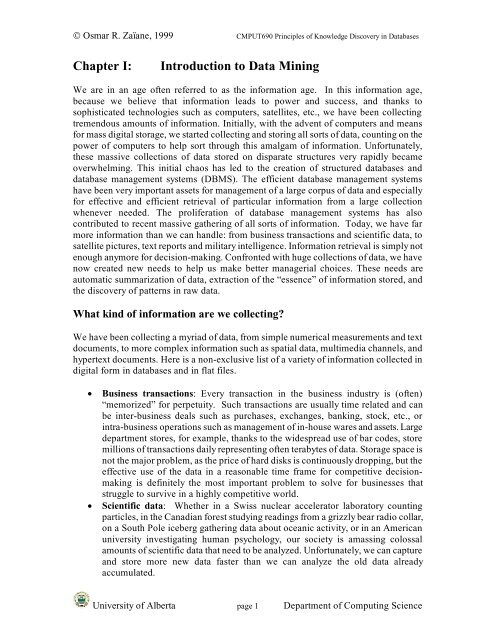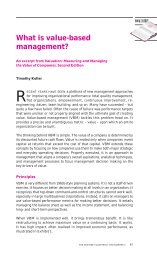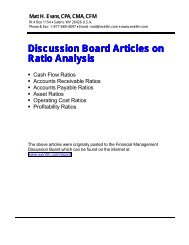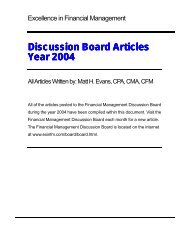Chapter I: Introduction to Data Mining
Chapter I: Introduction to Data Mining
Chapter I: Introduction to Data Mining
Create successful ePaper yourself
Turn your PDF publications into a flip-book with our unique Google optimized e-Paper software.
© Osmar R. Zaïane, 1999 CMPUT690 Principles of Knowledge Discovery in <strong>Data</strong>bases<br />
<strong>Chapter</strong> I:<br />
<strong>Introduction</strong> <strong>to</strong> <strong>Data</strong> <strong>Mining</strong><br />
We are in an age often referred <strong>to</strong> as the information age. In this information age,<br />
because we believe that information leads <strong>to</strong> power and success, and thanks <strong>to</strong><br />
sophisticated technologies such as computers, satellites, etc., we have been collecting<br />
tremendous amounts of information. Initially, with the advent of computers and means<br />
for mass digital s<strong>to</strong>rage, we started collecting and s<strong>to</strong>ring all sorts of data, counting on the<br />
power of computers <strong>to</strong> help sort through this amalgam of information. Unfortunately,<br />
these massive collections of data s<strong>to</strong>red on disparate structures very rapidly became<br />
overwhelming. This initial chaos has led <strong>to</strong> the creation of structured databases and<br />
database management systems (DBMS). The efficient database management systems<br />
have been very important assets for management of a large corpus of data and especially<br />
for effective and efficient retrieval of particular information from a large collection<br />
whenever needed. The proliferation of database management systems has also<br />
contributed <strong>to</strong> recent massive gathering of all sorts of information. Today, we have far<br />
more information than we can handle: from business transactions and scientific data, <strong>to</strong><br />
satellite pictures, text reports and military intelligence. Information retrieval is simply not<br />
enough anymore for decision-making. Confronted with huge collections of data, we have<br />
now created new needs <strong>to</strong> help us make better managerial choices. These needs are<br />
au<strong>to</strong>matic summarization of data, extraction of the “essence” of information s<strong>to</strong>red, and<br />
the discovery of patterns in raw data.<br />
What kind of information are we collecting?<br />
We have been collecting a myriad of data, from simple numerical measurements and text<br />
documents, <strong>to</strong> more complex information such as spatial data, multimedia channels, and<br />
hypertext documents. Here is a non-exclusive list of a variety of information collected in<br />
digital form in databases and in flat files.<br />
• Business transactions: Every transaction in the business industry is (often)<br />
“memorized” for perpetuity. Such transactions are usually time related and can<br />
be inter-business deals such as purchases, exchanges, banking, s<strong>to</strong>ck, etc., or<br />
intra-business operations such as management of in-house wares and assets. Large<br />
department s<strong>to</strong>res, for example, thanks <strong>to</strong> the widespread use of bar codes, s<strong>to</strong>re<br />
millions of transactions daily representing often terabytes of data. S<strong>to</strong>rage space is<br />
not the major problem, as the price of hard disks is continuously dropping, but the<br />
effective use of the data in a reasonable time frame for competitive decisionmaking<br />
is definitely the most important problem <strong>to</strong> solve for businesses that<br />
struggle <strong>to</strong> survive in a highly competitive world.<br />
• Scientific data: Whether in a Swiss nuclear accelera<strong>to</strong>r labora<strong>to</strong>ry counting<br />
particles, in the Canadian forest studying readings from a grizzly bear radio collar,<br />
on a South Pole iceberg gathering data about oceanic activity, or in an American<br />
university investigating human psychology, our society is amassing colossal<br />
amounts of scientific data that need <strong>to</strong> be analyzed. Unfortunately, we can capture<br />
and s<strong>to</strong>re more new data faster than we can analyze the old data already<br />
accumulated.<br />
University of Alberta page 1 Department of Computing Science
© Osmar R. Zaïane, 1999 CMPUT690 Principles of Knowledge Discovery in <strong>Data</strong>bases<br />
• Medical and personal data: From government census <strong>to</strong> personnel and cus<strong>to</strong>mer<br />
files, very large collections of information are continuously gathered about<br />
individuals and groups. Governments, companies and organizations such as<br />
hospitals, are s<strong>to</strong>ckpiling very important quantities of personal data <strong>to</strong> help them<br />
manage human resources, better understand a market, or simply assist clientele.<br />
Regardless of the privacy issues this type of data often reveals, this information is<br />
collected, used and even shared. When correlated with other data this information<br />
can shed light on cus<strong>to</strong>mer behaviour and the like.<br />
• Surveillance video and pictures: With the amazing collapse of video camera<br />
prices, video cameras are becoming ubiqui<strong>to</strong>us. Video tapes from surveillance<br />
cameras are usually recycled and thus the content is lost. However, there is a<br />
tendency <strong>to</strong>day <strong>to</strong> s<strong>to</strong>re the tapes and even digitize them for future use and<br />
analysis.<br />
• Satellite sensing: There is a countless number of satellites around the globe:<br />
some are geo-stationary above a region, and some are orbiting around the Earth,<br />
but all are sending a non-s<strong>to</strong>p stream of data <strong>to</strong> the surface. NASA, which controls<br />
a large number of satellites, receives more data every second than what all NASA<br />
researchers and engineers can cope with. Many satellite pictures and data are<br />
made public as soon as they are received in the hopes that other researchers can<br />
analyze them.<br />
• Games: Our society is collecting a tremendous amount of data and statistics about<br />
games, players and athletes. From hockey scores, basketball passes and car-racing<br />
lapses, <strong>to</strong> swimming times, boxer’s pushes and chess positions, all the data are<br />
s<strong>to</strong>red. Commenta<strong>to</strong>rs and journalists are using this information for reporting, but<br />
trainers and athletes would want <strong>to</strong> exploit this data <strong>to</strong> improve performance and<br />
better understand opponents.<br />
• Digital media: The proliferation of cheap scanners, desk<strong>to</strong>p video cameras and<br />
digital cameras is one of the causes of the explosion in digital media reposi<strong>to</strong>ries.<br />
In addition, many radio stations, television channels and film studios are<br />
digitizing their audio and video collections <strong>to</strong> improve the management of their<br />
multimedia assets. Associations such as the NHL and the NBA have already<br />
started converting their huge game collection in<strong>to</strong> digital forms.<br />
• CAD and Software engineering data: There are a multitude of Computer<br />
Assisted Design (CAD) systems for architects <strong>to</strong> design buildings or engineers <strong>to</strong><br />
conceive system components or circuits. These systems are generating a<br />
tremendous amount of data. Moreover, software engineering is a source of<br />
considerable similar data with code, function libraries, objects, etc., which need<br />
powerful <strong>to</strong>ols for management and maintenance.<br />
• Virtual Worlds: There are many applications making use of three-dimensional<br />
virtual spaces. These spaces and the objects they contain are described with<br />
special languages such as VRML. Ideally, these virtual spaces are described in<br />
such a way that they can share objects and places. There is a remarkable amount<br />
of virtual reality object and space reposi<strong>to</strong>ries available. Management of these<br />
reposi<strong>to</strong>ries as well as content-based search and retrieval from these reposi<strong>to</strong>ries<br />
are still research issues, while the size of the collections continues <strong>to</strong> grow.<br />
University of Alberta page 2 Department of Computing Science
© Osmar R. Zaïane, 1999 CMPUT690 Principles of Knowledge Discovery in <strong>Data</strong>bases<br />
• Text reports and memos (e-mail messages): Most of the communications within<br />
and between companies or research organizations or even private people, are<br />
based on reports and memos in textual forms often exchanged by e-mail. These<br />
messages are regularly s<strong>to</strong>red in digital form for future use and reference creating<br />
formidable digital libraries.<br />
• The World Wide Web reposi<strong>to</strong>ries: Since the inception of the World Wide Web<br />
in 1993, documents of all sorts of formats, content and description have been<br />
collected and inter-connected with hyperlinks making it the largest reposi<strong>to</strong>ry of<br />
data ever built. Despite its dynamic and unstructured nature, its heterogeneous<br />
characteristic, and its very often redundancy and inconsistency, the World Wide<br />
Web is the most important data collection regularly used for reference because of<br />
the broad variety of <strong>to</strong>pics covered and the infinite contributions of resources and<br />
publishers. Many believe that the World Wide Web will become the compilation<br />
of human knowledge.<br />
What are <strong>Data</strong> <strong>Mining</strong> and Knowledge Discovery?<br />
With the enormous amount of data s<strong>to</strong>red in files, databases, and other reposi<strong>to</strong>ries, it is<br />
increasingly important, if not necessary, <strong>to</strong> develop powerful means for analysis and<br />
perhaps interpretation of such data and for the extraction of interesting knowledge that<br />
could help in decision-making.<br />
<strong>Data</strong> <strong>Mining</strong>, also popularly known as Knowledge Discovery in <strong>Data</strong>bases (KDD), refers<br />
<strong>to</strong> the nontrivial extraction of implicit, previously unknown and potentially useful<br />
information from data in databases. While data mining and knowledge discovery in<br />
databases (or KDD) are frequently treated as synonyms, data mining is actually part of<br />
the knowledge discovery process. The following figure (Figure 1.1) shows data mining as<br />
a step in an iterative knowledge discovery process.<br />
Pattern<br />
Evaluation<br />
<strong>Data</strong><br />
Warehouse<br />
<strong>Data</strong><br />
Cleaning<br />
<strong>Data</strong>bases<br />
Task-relevant<br />
<strong>Data</strong><br />
<strong>Data</strong> Integration<br />
Selection and<br />
Transformation<br />
Figure 1.1: <strong>Data</strong> <strong>Mining</strong> is the core of Knowledge Discovery process<br />
University of Alberta page 3 Department of Computing Science
© Osmar R. Zaïane, 1999 CMPUT690 Principles of Knowledge Discovery in <strong>Data</strong>bases<br />
The Knowledge Discovery in <strong>Data</strong>bases process comprises of a few steps leading from<br />
raw data collections <strong>to</strong> some form of new knowledge. The iterative process consists of<br />
the following steps:<br />
• <strong>Data</strong> cleaning: also known as data cleansing, it is a phase in which noise data and<br />
irrelevant data are removed from the collection.<br />
• <strong>Data</strong> integration: at this stage, multiple data sources, often heterogeneous, may<br />
be combined in a common source.<br />
• <strong>Data</strong> selection: at this step, the data relevant <strong>to</strong> the analysis is decided on and<br />
retrieved from the data collection.<br />
• <strong>Data</strong> transformation: also known as data consolidation, it is a phase in which the<br />
selected data is transformed in<strong>to</strong> forms appropriate for the mining procedure.<br />
• <strong>Data</strong> mining: it is the crucial step in which clever techniques are applied <strong>to</strong><br />
extract patterns potentially useful.<br />
• Pattern evaluation: in this step, strictly interesting patterns representing<br />
knowledge are identified based on given measures.<br />
• Knowledge representation: is the final phase in which the discovered knowledge<br />
is visually represented <strong>to</strong> the user. This essential step uses visualization<br />
techniques <strong>to</strong> help users understand and interpret the data mining results.<br />
It is common <strong>to</strong> combine some of these steps <strong>to</strong>gether. For instance, data cleaning and<br />
data integration can be performed <strong>to</strong>gether as a pre-processing phase <strong>to</strong> generate a data<br />
warehouse. <strong>Data</strong> selection and data transformation can also be combined where the<br />
consolidation of the data is the result of the selection, or, as for the case of data<br />
warehouses, the selection is done on transformed data.<br />
The KDD is an iterative process. Once the discovered knowledge is presented <strong>to</strong> the user,<br />
the evaluation measures can be enhanced, the mining can be further refined, new data can<br />
be selected or further transformed, or new data sources can be integrated, in order <strong>to</strong> get<br />
different, more appropriate results.<br />
<strong>Data</strong> mining derives its name from the similarities between searching for valuable<br />
information in a large database and mining rocks for a vein of valuable ore. Both imply<br />
either sifting through a large amount of material or ingeniously probing the material <strong>to</strong><br />
exactly pinpoint where the values reside. It is, however, a misnomer, since mining for<br />
gold in rocks is usually called “gold mining” and not “rock mining”, thus by analogy,<br />
data mining should have been called “knowledge mining” instead. Nevertheless, data<br />
mining became the accepted cus<strong>to</strong>mary term, and very rapidly a trend that even<br />
overshadowed more general terms such as knowledge discovery in databases (KDD) that<br />
describe a more complete process. Other similar terms referring <strong>to</strong> data mining are: data<br />
dredging, knowledge extraction and pattern discovery.<br />
University of Alberta page 4 Department of Computing Science
© Osmar R. Zaïane, 1999 CMPUT690 Principles of Knowledge Discovery in <strong>Data</strong>bases<br />
What kind of <strong>Data</strong> can be mined?<br />
In principle, data mining is not specific <strong>to</strong> one type of media or data. <strong>Data</strong> mining should<br />
be applicable <strong>to</strong> any kind of information reposi<strong>to</strong>ry. However, algorithms and approaches<br />
may differ when applied <strong>to</strong> different types of data. Indeed, the challenges presented by<br />
different types of data vary significantly. <strong>Data</strong> mining is being put in<strong>to</strong> use and studied<br />
for databases, including relational databases, object-relational databases and objec<strong>to</strong>riented<br />
databases, data warehouses, transactional databases, unstructured and semistructured<br />
reposi<strong>to</strong>ries such as the World Wide Web, advanced databases such as spatial<br />
databases, multimedia databases, time-series databases and textual databases, and even<br />
flat files. Here are some examples in more detail:<br />
• Flat files: Flat files are actually the most common data source for data mining<br />
algorithms, especially at the research level. Flat files are simple data files in text<br />
or binary format with a structure known by the data mining algorithm <strong>to</strong> be<br />
applied. The data in these files can be transactions, time-series data, scientific<br />
measurements, etc.<br />
• Relational <strong>Data</strong>bases: Briefly, a relational database consists of a set of tables<br />
containing either values of entity attributes, or values of attributes from entity<br />
relationships. Tables have columns and rows, where columns represent attributes<br />
and rows represent tuples. A tuple in a relational table corresponds <strong>to</strong> either an<br />
object or a relationship between objects and is identified by a set of attribute<br />
values representing a unique key. In Figure 1.2 we present some relations<br />
Cus<strong>to</strong>mer, Items, and Borrow representing business activity in a fictitious video<br />
s<strong>to</strong>re OurVideoS<strong>to</strong>re. These relations are just a subset of what could be a<br />
database for the video s<strong>to</strong>re and is given as an example.<br />
Borrow<br />
cus<strong>to</strong>merID date itemID # …<br />
C1234 99/09/06 98765 1 …<br />
Cus<strong>to</strong>mer<br />
. . .<br />
cus<strong>to</strong>merID name address password birthdate family_income group …<br />
C1234 John Smith 120 main street Marty 1965/10/10 $45000 A …<br />
. . .<br />
Items<br />
itemID type title media category Value # …<br />
98765 Video Titanic DVD Drama $15.00 2 …<br />
. . .<br />
Figure 1.2: Fragments of some relations from a relational database for OurVideoS<strong>to</strong>re.<br />
University of Alberta page 5 Department of Computing Science
© Osmar R. Zaïane, 1999 CMPUT690 Principles of Knowledge Discovery in <strong>Data</strong>bases<br />
The most commonly used query language for relational database is SQL, which<br />
allows retrieval and manipulation of the data s<strong>to</strong>red in the tables, as well as the<br />
calculation of aggregate functions such as average, sum, min, max and count. For<br />
instance, an SQL query <strong>to</strong> select the videos grouped by category would be:<br />
SELECT count(*) FROM Items WHERE type=video GROUP BY category.<br />
<strong>Data</strong> mining algorithms using relational databases can be more versatile than data<br />
mining algorithms specifically written for flat files, since they can take advantage<br />
of the structure inherent <strong>to</strong> relational databases. While data mining can benefit<br />
from SQL for data selection, transformation and consolidation, it goes beyond<br />
what SQL could provide, such as predicting, comparing, detecting deviations, etc.<br />
• <strong>Data</strong> Warehouses: A data warehouse as a s<strong>to</strong>rehouse, is a reposi<strong>to</strong>ry of data<br />
collected from multiple data sources (often heterogeneous) and is intended <strong>to</strong> be<br />
used as a whole under the same unified schema. A data warehouse gives the<br />
option <strong>to</strong> analyze data from different sources under the same roof. Let us suppose<br />
that OurVideoS<strong>to</strong>re becomes a franchise in North America. Many video s<strong>to</strong>res<br />
belonging <strong>to</strong> OurVideoS<strong>to</strong>re company may have different databases and different<br />
structures. If the executive of the company wants <strong>to</strong> access the data from all s<strong>to</strong>res<br />
for strategic decision-making, future direction, marketing, etc., it would be more<br />
appropriate <strong>to</strong> s<strong>to</strong>re all the data in one site with a homogeneous structure that<br />
allows interactive analysis. In other words, data from the different s<strong>to</strong>res would be<br />
loaded, cleaned, transformed and integrated <strong>to</strong>gether. To facilitate decisionmaking<br />
and multi-dimensional views, data warehouses are usually modeled by a<br />
multi-dimensional data structure. Figure 1.3 shows an example of a three<br />
dimensional subset of a data cube structure used for OurVideoS<strong>to</strong>re data<br />
warehouse.<br />
Group By<br />
Category<br />
Drama<br />
Comedy<br />
Aggregate Horror<br />
Sum<br />
Sum<br />
Drama<br />
Comedy<br />
Horror<br />
By Time<br />
Cross Tab<br />
Q1 Q2 Q3 Q4 By Category<br />
Sum<br />
By City<br />
By Time & City<br />
By Category & City<br />
The <strong>Data</strong> Cube and<br />
The Sub-Space Aggregates<br />
Q1 Q2<br />
Q3 Q4<br />
Sum<br />
Red Deer<br />
Lethbridge<br />
Calgary<br />
Edmon<strong>to</strong>n<br />
By Category<br />
By Time<br />
Drama<br />
Comedy<br />
Horror<br />
By Time & Category<br />
Figure 1.3: A multi-dimensional data cube structure commonly used in data for data warehousing.<br />
University of Alberta page 6 Department of Computing Science
© Osmar R. Zaïane, 1999 CMPUT690 Principles of Knowledge Discovery in <strong>Data</strong>bases<br />
The figure shows summarized rentals grouped by film categories, then a cross<br />
table of summarized rentals by film categories and time (in quarters). The data<br />
cube gives the summarized rentals along three dimensions: category, time, and<br />
city. A cube contains cells that s<strong>to</strong>re values of some aggregate measures (in this<br />
case rental counts), and special cells that s<strong>to</strong>re summations along dimensions.<br />
Each dimension of the data cube contains a hierarchy of values for one attribute.<br />
Because of their structure, the pre-computed summarized data they contain and<br />
the hierarchical attribute values of their dimensions, data cubes are well suited for<br />
fast interactive querying and analysis of data at different conceptual levels, known<br />
as On-Line Analytical Processing (OLAP). OLAP operations allow the navigation<br />
of data at different levels of abstraction, such as drill-down, roll-up, slice, dice,<br />
etc. Figure 1.4 illustrates the drill-down (on the time dimension) and roll-up (on<br />
the location dimension) operations.<br />
Time (Quarters)<br />
Q1 Q2 Q3 Q4<br />
Location Edmon<strong>to</strong>n<br />
Calgary<br />
Drama<br />
(city, AB) Lethbridge<br />
Comedy<br />
Red Deer<br />
Horror<br />
Sci. Fi..<br />
Category<br />
Location<br />
Edmon<strong>to</strong>n<br />
Calgary<br />
(city, AB) Lethbridge<br />
Red Deer<br />
Drill down on Q3<br />
Time (Months, Q3)<br />
Jul Aug Se<br />
Drama<br />
Comedy<br />
Horror<br />
Sci. Fi..<br />
Category<br />
Roll-up on Location<br />
Location<br />
(province, Ontario<br />
Canada) Prairies<br />
Western Pr<br />
Maritimes<br />
Quebec<br />
Time (Quarters)<br />
Q1 Q2 Q3 Q4<br />
Drama<br />
Comedy<br />
Horror<br />
Sci. Fi..<br />
Category<br />
Figure 1.4: Summarized data from OurVideoS<strong>to</strong>re before and after drill-down and roll-up operations.<br />
• Transaction <strong>Data</strong>bases: A transaction database is a set of records representing<br />
transactions, each with a time stamp, an identifier and a set of items. Associated<br />
with the transaction files could also be descriptive data for the items. For<br />
example, in the case of the video s<strong>to</strong>re, the rentals table such as shown in Figure<br />
1.5, represents the transaction database. Each record is a rental contract with a<br />
cus<strong>to</strong>mer identifier, a date, and the list of items rented (i.e. video tapes, games,<br />
VCR, etc.). Since relational databases do not allow nested tables (i.e. a set as<br />
attribute value), transactions are usually s<strong>to</strong>red in flat files or s<strong>to</strong>red in two<br />
normalized transaction tables, one for the transactions and one for the transaction<br />
items. One typical data mining analysis on such data is the so-called market<br />
University of Alberta page 7 Department of Computing Science
© Osmar R. Zaïane, 1999 CMPUT690 Principles of Knowledge Discovery in <strong>Data</strong>bases<br />
basket analysis or association rules in which associations between items occurring<br />
<strong>to</strong>gether or in sequence are studied.<br />
Rentals<br />
transactionID date time cus<strong>to</strong>merID itemList<br />
T12345 99/09/06 19:38 C1234 {I2, I6, I10, I45 …}<br />
. . .<br />
Figure 1.5: Fragment of a transaction database for the rentals at OurVideoS<strong>to</strong>re.<br />
• Multimedia <strong>Data</strong>bases: Multimedia databases include video, images, audio and<br />
text media. They can be s<strong>to</strong>red on extended object-relational or object-oriented<br />
databases, or simply on a file system. Multimedia is characterized by its high<br />
dimensionality, which makes data mining even more challenging. <strong>Data</strong> mining<br />
from multimedia reposi<strong>to</strong>ries may require computer vision, computer graphics,<br />
image interpretation, and natural language processing methodologies.<br />
• Spatial <strong>Data</strong>bases: Spatial databases are databases that, in addition <strong>to</strong> usual data,<br />
s<strong>to</strong>re geographical information like maps, and global or regional positioning. Such<br />
spatial databases present new challenges <strong>to</strong> data mining algorithms.<br />
Figure 1.6: Visualization of spatial OLAP (from GeoMiner system)<br />
• Time-Series <strong>Data</strong>bases: Time-series databases contain time related data such<br />
s<strong>to</strong>ck market data or logged activities. These databases usually have a continuous<br />
flow of new data coming in, which sometimes causes the need for a challenging<br />
real time analysis. <strong>Data</strong> mining in such databases commonly includes the study of<br />
trends and correlations between evolutions of different variables, as well as the<br />
prediction of trends and movements of the variables in time. Figure 1.7 shows<br />
some examples of time-series data.<br />
University of Alberta page 8 Department of Computing Science
© Osmar R. Zaïane, 1999 CMPUT690 Principles of Knowledge Discovery in <strong>Data</strong>bases<br />
Figure 1.7: Examples of Time-Series <strong>Data</strong><br />
(Source: Thompson Inves<strong>to</strong>rs Group)<br />
• World Wide Web: The World Wide Web is the most heterogeneous and dynamic<br />
reposi<strong>to</strong>ry available. A very large number of authors and publishers are<br />
continuously contributing <strong>to</strong> its growth and metamorphosis, and a massive<br />
number of users are accessing its resources daily. <strong>Data</strong> in the World Wide Web is<br />
organized in inter-connected documents. These documents can be text, audio,<br />
video, raw data, and even applications. Conceptually, the World Wide Web is<br />
comprised of three major components: The content of the Web, which<br />
encompasses documents available; the structure of the Web, which covers the<br />
hyperlinks and the relationships between documents; and the usage of the web,<br />
describing how and when the resources are accessed. A fourth dimension can be<br />
added relating the dynamic nature or evolution of the documents. <strong>Data</strong> mining in<br />
the World Wide Web, or web mining, tries <strong>to</strong> address all these issues and is often<br />
divided in<strong>to</strong> web content mining, web structure mining and web usage mining.<br />
What can be discovered?<br />
The kinds of patterns that can be discovered depend upon the data mining tasks<br />
employed. By and large, there are two types of data mining tasks: descriptive data mining<br />
tasks that describe the general properties of the existing data, and predictive data mining<br />
tasks that attempt <strong>to</strong> do predictions based on inference on available data.<br />
The data mining functionalities and the variety of knowledge they discover are briefly<br />
presented in the following list:<br />
University of Alberta page 9 Department of Computing Science
© Osmar R. Zaïane, 1999 CMPUT690 Principles of Knowledge Discovery in <strong>Data</strong>bases<br />
• Characterization: <strong>Data</strong> characterization is a summarization of general features of<br />
objects in a target class, and produces what is called characteristic rules. The data<br />
relevant <strong>to</strong> a user-specified class are normally retrieved by a database query and<br />
run through a summarization module <strong>to</strong> extract the essence of the data at different<br />
levels of abstractions. For example, one may want <strong>to</strong> characterize the<br />
OurVideoS<strong>to</strong>re cus<strong>to</strong>mers who regularly rent more than 30 movies a year. With<br />
concept hierarchies on the attributes describing the target class, the attributeoriented<br />
induction method can be used, for example, <strong>to</strong> carry out data<br />
summarization. Note that with a data cube containing summarization of data,<br />
simple OLAP operations fit the purpose of data characterization.<br />
• Discrimination: <strong>Data</strong> discrimination produces what are called discriminant rules<br />
and is basically the comparison of the general features of objects between two<br />
classes referred <strong>to</strong> as the target class and the contrasting class. For example, one<br />
may want <strong>to</strong> compare the general characteristics of the cus<strong>to</strong>mers who rented<br />
more than 30 movies in the last year with those whose rental account is lower<br />
than 5. The techniques used for data discrimination are very similar <strong>to</strong> the<br />
techniques used for data characterization with the exception that data<br />
discrimination results include comparative measures.<br />
• Association analysis: Association analysis is the discovery of what are<br />
commonly called association rules. It studies the frequency of items occurring<br />
<strong>to</strong>gether in transactional databases, and based on a threshold called support,<br />
identifies the frequent item sets. Another threshold, confidence, which is the<br />
conditional probability than an item appears in a transaction when another item<br />
appears, is used <strong>to</strong> pinpoint association rules. Association analysis is commonly<br />
used for market basket analysis. For example, it could be useful for the<br />
OurVideoS<strong>to</strong>re manager <strong>to</strong> know what movies are often rented <strong>to</strong>gether or if there<br />
is a relationship between renting a certain type of movies and buying popcorn or<br />
pop. The discovered association rules are of the form: P→Q [s,c], where P and Q<br />
are conjunctions of attribute value-pairs, and s (for support) is the probability that<br />
P and Q appear <strong>to</strong>gether in a transaction and c (for confidence) is the conditional<br />
probability that Q appears in a transaction when P is present. For example, the<br />
hypothetic association rule:<br />
RentType(X, “game”) ∧ Age(X, “13-19”) → Buys(X, “pop”) [s=2% ,c=55%]<br />
would indicate that 2% of the transactions considered are of cus<strong>to</strong>mers aged<br />
between 13 and 19 who are renting a game and buying a pop, and that there is a<br />
certainty of 55% that teenage cus<strong>to</strong>mers who rent a game also buy pop.<br />
• Classification: Classification analysis is the organization of data in given classes.<br />
Also known as supervised classification, the classification uses given class labels<br />
<strong>to</strong> order the objects in the data collection. Classification approaches normally use<br />
a training set where all objects are already associated with known class labels.<br />
The classification algorithm learns from the training set and builds a model. The<br />
model is used <strong>to</strong> classify new objects. For example, after starting a credit policy,<br />
the OurVideoS<strong>to</strong>re managers could analyze the cus<strong>to</strong>mers’ behaviours vis-à-vis<br />
their credit, and label accordingly the cus<strong>to</strong>mers who received credits with three<br />
possible labels “safe”, “risky” and “very risky”. The classification analysis would<br />
University of Alberta page 10 Department of Computing Science
© Osmar R. Zaïane, 1999 CMPUT690 Principles of Knowledge Discovery in <strong>Data</strong>bases<br />
generate a model that could be used <strong>to</strong> either accept or reject credit requests in the<br />
future.<br />
• Prediction: Prediction has attracted considerable attention given the potential<br />
implications of successful forecasting in a business context. There are two major<br />
types of predictions: one can either try <strong>to</strong> predict some unavailable data values or<br />
pending trends, or predict a class label for some data. The latter is tied <strong>to</strong><br />
classification. Once a classification model is built based on a training set, the class<br />
label of an object can be foreseen based on the attribute values of the object and<br />
the attribute values of the classes. Prediction is however more often referred <strong>to</strong> the<br />
forecast of missing numerical values, or increase/ decrease trends in time related<br />
data. The major idea is <strong>to</strong> use a large number of past values <strong>to</strong> consider probable<br />
future values.<br />
• Clustering: Similar <strong>to</strong> classification, clustering is the organization of data in<br />
classes. However, unlike classification, in clustering, class labels are unknown<br />
and it is up <strong>to</strong> the clustering algorithm <strong>to</strong> discover acceptable classes. Clustering is<br />
also called unsupervised classification, because the classification is not dictated<br />
by given class labels. There are many clustering approaches all based on the<br />
principle of maximizing the similarity between objects in a same class (intra-class<br />
similarity) and minimizing the similarity between objects of different classes<br />
(inter-class similarity).<br />
• Outlier analysis: Outliers are data elements that cannot be grouped in a given<br />
class or cluster. Also known as exceptions or surprises, they are often very<br />
important <strong>to</strong> identify. While outliers can be considered noise and discarded in<br />
some applications, they can reveal important knowledge in other domains, and<br />
thus can be very significant and their analysis valuable.<br />
• Evolution and deviation analysis: Evolution and deviation analysis pertain <strong>to</strong> the<br />
study of time related data that changes in time. Evolution analysis models<br />
evolutionary trends in data, which consent <strong>to</strong> characterizing, comparing,<br />
classifying or clustering of time related data. Deviation analysis, on the other<br />
hand, considers differences between measured values and expected values, and<br />
attempts <strong>to</strong> find the cause of the deviations from the anticipated values.<br />
It is common that users do not have a clear idea of the kind of patterns they can discover<br />
or need <strong>to</strong> discover from the data at hand. It is therefore important <strong>to</strong> have a versatile and<br />
inclusive data mining system that allows the discovery of different kinds of knowledge<br />
and at different levels of abstraction. This also makes interactivity an important attribute<br />
of a data mining system.<br />
Is all that is discovered interesting and useful?<br />
<strong>Data</strong> mining allows the discovery of knowledge potentially useful and unknown. Whether<br />
the knowledge discovered is new, useful or interesting, is very subjective and depends<br />
upon the application and the user. It is certain that data mining can generate, or discover,<br />
a very large number of patterns or rules. In some cases the number of rules can reach the<br />
millions. One can even think of a meta-mining phase <strong>to</strong> mine the oversized data mining<br />
results. To reduce the number of patterns or rules discovered that have a high probability<br />
University of Alberta page 11 Department of Computing Science
© Osmar R. Zaïane, 1999 CMPUT690 Principles of Knowledge Discovery in <strong>Data</strong>bases<br />
<strong>to</strong> be non-interesting, one has <strong>to</strong> put a measurement on the patterns. However, this raises<br />
the problem of completeness. The user would want <strong>to</strong> discover all rules or patterns, but<br />
only those that are interesting. The measurement of how interesting a discovery is, often<br />
called interestingness, can be based on quantifiable objective elements such as validity of<br />
the patterns when tested on new data with some degree of certainty, or on some<br />
subjective depictions such as understandability of the patterns, novelty of the patterns, or<br />
usefulness.<br />
Discovered patterns can also be found interesting if they confirm or validate a hypothesis<br />
sought <strong>to</strong> be confirmed or unexpectedly contradict a common belief. This brings the issue<br />
of describing what is interesting <strong>to</strong> discover, such as meta-rule guided discovery that<br />
describes forms of rules before the discovery process, and interestingness refinement<br />
languages that interactively query the results for interesting patterns after the discovery<br />
phase. Typically, measurements for interestingness are based on thresholds set by the<br />
user. These thresholds define the completeness of the patterns discovered.<br />
Identifying and measuring the interestingness of patterns and rules discovered, or <strong>to</strong> be<br />
discovered, is essential for the evaluation of the mined knowledge and the KDD process<br />
as a whole. While some concrete measurements exist, assessing the interestingness of<br />
discovered knowledge is still an important research issue.<br />
How do we categorize data mining systems?<br />
There are many data mining systems available or being developed. Some are specialized<br />
systems dedicated <strong>to</strong> a given data source or are confined <strong>to</strong> limited data mining<br />
functionalities, other are more versatile and comprehensive. <strong>Data</strong> mining systems can be<br />
categorized according <strong>to</strong> various criteria among other classification are the following:<br />
• Classification according <strong>to</strong> the type of data source mined: this classification<br />
categorizes data mining systems according <strong>to</strong> the type of data handled such as<br />
spatial data, multimedia data, time-series data, text data, World Wide Web, etc.<br />
• Classification according <strong>to</strong> the data model drawn on: this classification<br />
categorizes data mining systems based on the data model involved such as<br />
relational database, object-oriented database, data warehouse, transactional, etc.<br />
• Classification according <strong>to</strong> the king of knowledge discovered: this<br />
classification categorizes data mining systems based on the kind of knowledge<br />
discovered or data mining functionalities, such as characterization, discrimination,<br />
association, classification, clustering, etc. Some systems tend <strong>to</strong> be<br />
comprehensive systems offering several data mining functionalities <strong>to</strong>gether.<br />
• Classification according <strong>to</strong> mining techniques used: <strong>Data</strong> mining systems<br />
employ and provide different techniques. This classification categorizes data<br />
mining systems according <strong>to</strong> the data analysis approach used such as machine<br />
learning, neural networks, genetic algorithms, statistics, visualization, databaseoriented<br />
or data warehouse-oriented, etc. The classification can also take in<strong>to</strong><br />
account the degree of user interaction involved in the data mining process such as<br />
query-driven systems, interactive explora<strong>to</strong>ry systems, or au<strong>to</strong>nomous systems. A<br />
University of Alberta page 12 Department of Computing Science
© Osmar R. Zaïane, 1999 CMPUT690 Principles of Knowledge Discovery in <strong>Data</strong>bases<br />
comprehensive system would provide a wide variety of data mining techniques <strong>to</strong><br />
fit different situations and options, and offer different degrees of user interaction.<br />
What are the issues in <strong>Data</strong> <strong>Mining</strong>?<br />
<strong>Data</strong> mining algorithms embody techniques that have sometimes existed for many years,<br />
but have only lately been applied as reliable and scalable <strong>to</strong>ols that time and again<br />
outperform older classical statistical methods. While data mining is still in its infancy, it<br />
is becoming a trend and ubiqui<strong>to</strong>us. Before data mining develops in<strong>to</strong> a conventional,<br />
mature and trusted discipline, many still pending issues have <strong>to</strong> be addressed. Some of<br />
these issues are addressed below. Note that these issues are not exclusive and are not<br />
ordered in any way.<br />
Security and social issues: Security is an important issue with any data collection that is<br />
shared and/or is intended <strong>to</strong> be used for strategic decision-making. In addition, when data<br />
is collected for cus<strong>to</strong>mer profiling, user behaviour understanding, correlating personal<br />
data with other information, etc., large amounts of sensitive and private information<br />
about individuals or companies is gathered and s<strong>to</strong>red. This becomes controversial given<br />
the confidential nature of some of this data and the potential illegal access <strong>to</strong> the<br />
information. Moreover, data mining could disclose new implicit knowledge about<br />
individuals or groups that could be against privacy policies, especially if there is potential<br />
dissemination of discovered information. Another issue that arises from this concern is<br />
the appropriate use of data mining. Due <strong>to</strong> the value of data, databases of all sorts of<br />
content are regularly sold, and because of the competitive advantage that can be attained<br />
from implicit knowledge discovered, some important information could be withheld,<br />
while other information could be widely distributed and used without control.<br />
User interface issues: The knowledge discovered by data mining <strong>to</strong>ols is useful as long<br />
as it is interesting, and above all understandable by the user. Good data visualization<br />
eases the interpretation of data mining results, as well as helps users better understand<br />
their needs. Many data explora<strong>to</strong>ry analysis tasks are significantly facilitated by the<br />
ability <strong>to</strong> see data in an appropriate visual presentation. There are many visualization<br />
ideas and proposals for effective data graphical presentation. However, there is still much<br />
research <strong>to</strong> accomplish in order <strong>to</strong> obtain good visualization <strong>to</strong>ols for large datasets that<br />
could be used <strong>to</strong> display and manipulate mined knowledge. The major issues related <strong>to</strong><br />
user interfaces and visualization are “screen real-estate”, information rendering, and<br />
interaction. Interactivity with the data and data mining results is crucial since it provides<br />
means for the user <strong>to</strong> focus and refine the mining tasks, as well as <strong>to</strong> picture the<br />
discovered knowledge from different angles and at different conceptual levels.<br />
<strong>Mining</strong> methodology issues: These issues pertain <strong>to</strong> the data mining approaches applied<br />
and their limitations. Topics such as versatility of the mining approaches, the diversity of<br />
data available, the dimensionality of the domain, the broad analysis needs (when known),<br />
the assessment of the knowledge discovered, the exploitation of background knowledge<br />
and metadata, the control and handling of noise in data, etc. are all examples that can<br />
dictate mining methodology choices. For instance, it is often desirable <strong>to</strong> have different<br />
University of Alberta page 13 Department of Computing Science
© Osmar R. Zaïane, 1999 CMPUT690 Principles of Knowledge Discovery in <strong>Data</strong>bases<br />
data mining methods available since different approaches may perform differently<br />
depending upon the data at hand. Moreover, different approaches may suit and solve<br />
user’s needs differently.<br />
Most algorithms assume the data <strong>to</strong> be noise-free. This is of course a strong assumption.<br />
Most datasets contain exceptions, invalid or incomplete information, etc., which may<br />
complicate, if not obscure, the analysis process and in many cases compromise the<br />
accuracy of the results. As a consequence, data preprocessing (data cleaning and<br />
transformation) becomes vital. It is often seen as lost time, but data cleaning, as timeconsuming<br />
and frustrating as it may be, is one of the most important phases in the<br />
knowledge discovery process. <strong>Data</strong> mining techniques should be able <strong>to</strong> handle noise in<br />
data or incomplete information.<br />
More than the size of data, the size of the search space is even more decisive for data<br />
mining techniques. The size of the search space is often depending upon the number of<br />
dimensions in the domain space. The search space usually grows exponentially when the<br />
number of dimensions increases. This is known as the curse of dimensionality. This<br />
“curse” affects so badly the performance of some data mining approaches that it is<br />
becoming one of the most urgent issues <strong>to</strong> solve.<br />
Performance issues: Many artificial intelligence and statistical methods exist for data<br />
analysis and interpretation. However, these methods were often not designed for the very<br />
large data sets data mining is dealing with <strong>to</strong>day. Terabyte sizes are common. This raises<br />
the issues of scalability and efficiency of the data mining methods when processing<br />
considerably large data. Algorithms with exponential and even medium-order polynomial<br />
complexity cannot be of practical use for data mining. Linear algorithms are usually the<br />
norm. In same theme, sampling can be used for mining instead of the whole dataset.<br />
However, concerns such as completeness and choice of samples may arise. Other <strong>to</strong>pics<br />
in the issue of performance are incremental updating, and parallel programming. There<br />
is no doubt that parallelism can help solve the size problem if the dataset can be<br />
subdivided and the results can be merged later. Incremental updating is important for<br />
merging results from parallel mining, or updating data mining results when new data<br />
becomes available without having <strong>to</strong> re-analyze the complete dataset.<br />
<strong>Data</strong> source issues: There are many issues related <strong>to</strong> the data sources, some are practical<br />
such as the diversity of data types, while others are philosophical like the data glut<br />
problem. We certainly have an excess of data since we already have more data than we<br />
can handle and we are still collecting data at an even higher rate. If the spread of database<br />
management systems has helped increase the gathering of information, the advent of data<br />
mining is certainly encouraging more data harvesting. The current practice is <strong>to</strong> collect as<br />
much data as possible now and process it, or try <strong>to</strong> process it, later. The concern is<br />
whether we are collecting the right data at the appropriate amount, whether we know<br />
what we want <strong>to</strong> do with it, and whether we distinguish between what data is important<br />
and what data is insignificant. Regarding the practical issues related <strong>to</strong> data sources, there<br />
is the subject of heterogeneous databases and the focus on diverse complex data types.<br />
We are s<strong>to</strong>ring different types of data in a variety of reposi<strong>to</strong>ries. It is difficult <strong>to</strong> expect a<br />
University of Alberta page 14 Department of Computing Science
© Osmar R. Zaïane, 1999 CMPUT690 Principles of Knowledge Discovery in <strong>Data</strong>bases<br />
data mining system <strong>to</strong> effectively and efficiently achieve good mining results on all kinds<br />
of data and sources. Different kinds of data and sources may require distinct algorithms<br />
and methodologies. Currently, there is a focus on relational databases and data<br />
warehouses, but other approaches need <strong>to</strong> be pioneered for other specific complex data<br />
types. A versatile data mining <strong>to</strong>ol, for all sorts of data, may not be realistic. Moreover,<br />
the proliferation of heterogeneous data sources, at structural and semantic levels, poses<br />
important challenges not only <strong>to</strong> the database community but also <strong>to</strong> the data mining<br />
community.<br />
References<br />
• M. S. Chen, J. Han, and P. S. Yu. <strong>Data</strong> mining: An overview from a database<br />
perspective. IEEE Trans. Knowledge and <strong>Data</strong> Engineering, 8:866-883, 1996.<br />
• U. M. Fayyad, G. Piatetsky-Shapiro, P. Smyth, and R. Uthurusamy.<br />
Advances in Knowledge Discovery and <strong>Data</strong> <strong>Mining</strong>. AAAI/MIT Press, 1996.<br />
• W. J. Frawley, G. Piatetsky-Shapiro and C. J. Matheus, Knowledge<br />
Discovery in <strong>Data</strong>bases: An Overview. In G. Piatetsky-Shapiro et al. (eds.),<br />
Knowledge Discovery in <strong>Data</strong>bases. AAAI/MIT Press, 1991.<br />
• J. Han and M. Kamber. <strong>Data</strong> <strong>Mining</strong>: Concepts and Techniques. Morgan<br />
Kaufmann, 2000.<br />
• T. Imielinski and H. Mannila. A database perspective on knowledge<br />
discovery. Communications of ACM, 39:58-64, 1996.<br />
• G. Piatetsky-Shapiro, U. M. Fayyad, and P. Smyth. From data mining <strong>to</strong><br />
knowledge discovery: An overview. In U.M. Fayyad, et al. (eds.), Advances in<br />
Knowledge Discovery and <strong>Data</strong> <strong>Mining</strong>, 1-35. AAAI/MIT Press, 1996.<br />
• G. Piatetsky-Shapiro and W. J. Frawley. Knowledge Discovery in <strong>Data</strong>bases.<br />
AAAI/MIT Press, 1991.<br />
University of Alberta page 15 Department of Computing Science
















